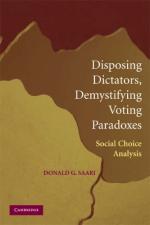|
This section contains 636 words (approx. 3 pages at 300 words per page) |

|
Voting paradoxes can arise in any election involving three or more candidates; though they come in many different forms, they can all be summed up in a single statement: Even if every voter is individually rational, society as a whole is not.
The most commonly used voting method in the United States is the plurality vote: Each voter casts a ballot for one candidate, and the winner is the candidate who gets the most votes (even if this is less than 50 percent). Though this system is familiar, it is rife with inconsistencies. Consider, for example, a situation where 9 people are deciding which one of three restaurants to eat dinner at. Each person ranks the three restaurants, and the rankings are as follows:
- 4 people rank A best, B second, and C third.
- 3 people rank B best, C second, and A third.
- 2 people rank C best, B second...
|
This section contains 636 words (approx. 3 pages at 300 words per page) |

|


